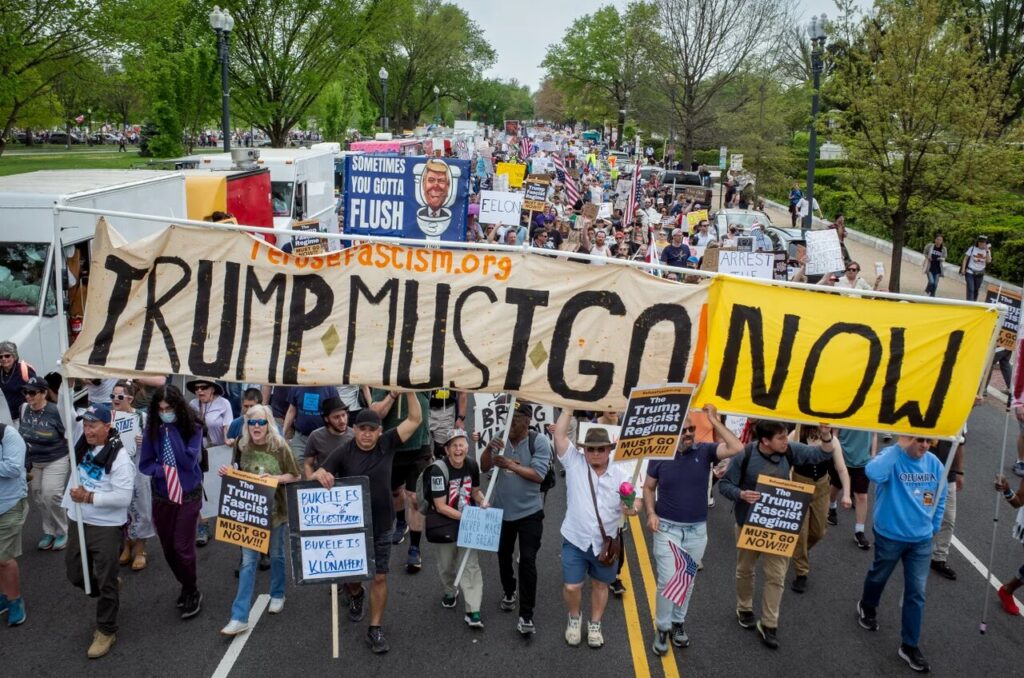TEHRAN – The nationwide “50501” protest held on April 19 represents an important and multi-faceted grassroots mobilization for President Donald Trump’s policy and governance style in his second term.
The 50501 movement has launched a strategic escalation by organizing demonstrations across all 50 states to turn widespread public opposition into sustained political pressures.
In the first few months of 2025, the 50501 movement was formed to counter what its organizers labeled as an authoritarian takeover by the Trump administration through hostile means. The move that began at the Reddit Forum in January has quickly transformed into a nationwide network of protests that operates under Banner 50 protests in one move in 50 states.
The core complexity and motivation of protesters
The protests characterized a broad spectrum of political dissatisfaction with the Trump administration about its policy issues and style of governance. The central issues include:
Overreaching of enforcement and erosion of democratic norms: Protesters accused Trump of using executive orders to dismantle federal agencies, reduce media access and raise questions about judicial decisions. Many recognize these actions as undermining constitutional checks and balance while defending the rule of law.
Immigration and Due Process Violation: The illegal deportation of green cardholder and activist Kilmer Abrego Garcia has become a flashpoint for rage towards El Salvador, which has no legitimate process. Thus, their individual cases have become symbolic of the broader issues of offensive immigration enforcement, crimes of objection, and violations of civil liberty.
Economic inequality and “billionaire acquisition”: protesters highlighted the reduction in employment from the Elon Musk-led Bureau of Government Efficiency (DOGE), increased costs of living, and the relative integration of power by rich elites into the administration’s economic policies. They have particularly targeted individuals like Mask to exert influence on government decisions and curb objections.
Civil Rights and Social Justice: Protesters have raised vigilance against threats to voting rights, reproductive health, racial justice, and protection of marginalized communities. The protesters also expressed solidarity with other humanitarian issues, particularly pro-Palestinian expressions, and linked US foreign policy to the domestic struggle for justice.
Historical and Symbolic Framing: Many protests, such as the Philadelphia rally at Independent National Historical Park, evoked revolutionary images and slogans such as “No Kings,” drawing parallels between monarchy and modern resistance to perceived authoritarianism.
Size, diversity, tactics
The Trump 50501 protests are said to be unprecedented, with over 525 protests taking place outside the state and federal capitals, courts, city halls, and in iconic locations against Tesla dealers. The emphasis on nonviolence is retained throughout the movement. It’s in terms of maintaining democratic principles, but there was a small conflict, leading to an argument that Pro Trump individuals faced destructively with Democrat representatives.
In addition to street protests, many events include community support initiatives such as food drives and mutual aid, which intensifies political protests in social solidarity. The dual focus strengthens claims on legitimacy and further expands constituencies where the resulting policy was felt to be effective.
Political and social implications
The 50501 protests are associated and signalled by deepening political disparities and crisis in legitimacy in governance. Polls show support for Trump is slipping, particularly in terms of economic issues and civil rights. The protests and political crisis are demonstrations that amplify the real issues reflected in the polls.
Controversially, framing as a fascist or authoritarian in the Trump administration has struck a note of resonance from participants that resemble history similar to the Nazis and other oppressive governments. The protest reflects division within the Democratic Party and broadly reflects opposition.
For example, protesters expressed dissatisfaction with political establishments that include the Democrats and their leaders, despite their recognition of the administration’s “Project 2025” playbook, and expressed inaction or slow response to the crisis based on historical atrocities.
The sector speaks of the challenges posed by countering grassroots mobilization to political action.
Conversely, the apparent lack of official responses to protests on behalf of the Trump administration shows a strategy of ignoring criticism, specifically disputes, or criticism that reduces the relevance of protests. This could help ease the water temperature of the protest or create a larger boiling pot, depending on how these events occur.
Finally, the April 19 protest, part of the 50501 movement, represents a pivotal moment in modern American political activity, characterized by the Trump administration’s policy direction and collective opposition to authoritarianism.
Historically rooted in grassroots organizing movements and historical resonances, the 50501 movement represents challenges to government activities, including administrative overreach, immigration enforcement, and welfare inequality, and directs its energy towards civil rights.

